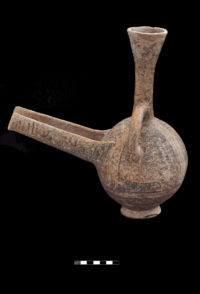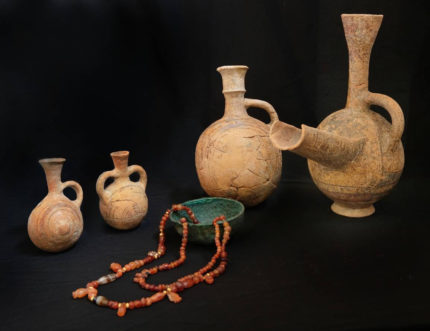 The grave of a small nuclear family — two adults buried with a child — has been unearthed in the ancient Phoenician city of Achziv on the northern coast of Israel near the border with Lebanon. The cist grave is 2,800 years old. Achziv was an important Phoenician port city at that time and the family’s graves goods attest to their prosperity.
The grave of a small nuclear family — two adults buried with a child — has been unearthed in the ancient Phoenician city of Achziv on the northern coast of Israel near the border with Lebanon. The cist grave is 2,800 years old. Achziv was an important Phoenician port city at that time and the family’s graves goods attest to their prosperity.
Discovered during a 2017 excavation, the grave was dug in the ground and then lined with field stones creating a clean rectangular structure that was then sealed by two large limestone slabs. Within its confines were the bones of a child between three to five years old, an adult woman and an adult man. The remains of the adults were in fetal position. The child’s bones had fallen into a heap so its burial position could not be ascertained.
 Interred with the remains were a bronze bowl and seven decorated pottery vessels. One of them is the largest Phoenician amphora ever discovered in Israel. The child was buried wearing a bead necklace of gold, silver, agate, amber and carnelian.
Interred with the remains were a bronze bowl and seven decorated pottery vessels. One of them is the largest Phoenician amphora ever discovered in Israel. The child was buried wearing a bead necklace of gold, silver, agate, amber and carnelian.
A wealthy family’s tomb fits the archaeological picture of Achziv as a thriving community over the centuries with several distinguished families, which by the way had four cemeteries in ancient times. In the 1960s, several cist graves were uncovered, one with two bodies buried with cylinder seals, bronze bowls, a bronze double axe, lance heads, and an ivory bowl with lion couchant. Other graves contained pottery, figurines, scarabs, and bronze and silver jewelry, also pointing to wealth. […]
In 2015 the excavators found what may be the only known mold for a supposed death mask, of a man, in what seems to have been a cultic building from the ninth century B.C.E. in the city’s south. The building, of which remained two mud-brick walls and three white plastered stairs that may have led to a second story, also contained several intact vessels, including a carinated bowl, chalices, a cooking pot, a storage jar, a lamp, and a goblet of burnished clay, as well as burnt animal bones. The archaeologists suspect it served a cultic function. […]
It was while trying to better understand the apparently cultic area that the archaeologists stumbled upon the tomb containing the nuclear family, dating to around 800 B.C.E., when Achziv was at its peak and some 100 years before the city surrendered to Sennacherib’s army.

The Phoenicians, followed by the Minoans, are my two favorites of antiquity. Thanks for the article.
Achziv has a great national park including a beautiful beach and a Crusader castle. One of my favorite places to visit and to camp.
Merry Christmas! :confused: …and that nuclear family fell victim to one of the “singular” 9th century BC Middle Eastern Mediterranean conflicts?
——-
Herodotus Bk.5, 58 in the fifth century BC: “These Phenicians […] brought to the Hellenes many arts when they settled in this land of Boeotia, and especially letters, which did not exist, as it appears to me, among the Hellenes before this time; and at first they brought in those which are used by the Phenicians generally, but afterwards, as time went on, they changed with their speech the form of the letters also. [the Ionians] changed their form slightly and so made use of them, and in doing so they declared them to be called ‘phenicians’, as was just, seeing that the Phenicians had introduced them into Hellas. Also the Ionians from ancient time call paper “skins,” because formerly, paper being scarce, they used skins of goat and sheep [, and] even in my own time many of the Barbarians write on such skins.”
——-
In the ancient Eastern Mediterranean, family graves were actually regularly visited –with food and drink. At least some of them were to a certain extent reused over generations. Were possibly any letters found? In Greek mythology, Phoinix (Φοῖνιξ, gen.: Φοίνικος means “sun-red”) is the eponym of Phoenicia who together with his brothers were tasked to find their abducted sister “Europa” in Crete.
And here things get complicated: “Modern archaeologists agree that the Philistines were different from their neighbors: Their arrival on the eastern shores of the Mediterranean in the early 12th century BC is marked by pottery with close parallels to the ancient Greek world, the use of an Aegean—instead of a Semitic—script, and the consumption of pork.” –Apparently, someone had ended up in Greece, while some others had become Philistines.